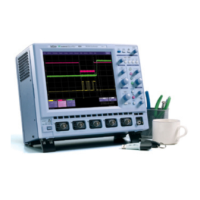RS-232-C Operation 4
COMMANDS SIMULATING
GPIB COMMANDS
<ESC>C or <ESC>c
Device clear command.
<ESC>R or <ESC>r
Set to remote command
(REN)
<ESC>L or <ESC>I
Set to local command
<ESC>F or <ESC>f
Set local lockout command
<ESC>T or <ESC>t
Trigger command (GET)
This also applies to line split characters inside strings sent to the
oscilloscope.
However, hex-ASCII data sent to the oscilloscope may contain
line split characters. If you wish to use line splitting, ensure that
neither the input message terminator characters nor the line split
characters occur in the data.
This command clears the input and output buffers. It has the same
meaning as the GPIB DCL or SDC interface messages.
This command puts the oscilloscope into the remote mode. Its
function is the same as GPIB asserting the REN line and setting the
oscilloscope to listener.
This command puts the oscilloscope into local mode. It clears local
lockout. It has the same function as GPIB setting the REN line to
false.
This command disables the front-panel "LOCAL" button either
immediately if the oscilloscope is already in the remote mode or
later when the oscilloscope is next set to remote control. This dis-
abling of the front-panel "LOCAL" button is called "Local
Lockout" and can only be cancelled with the <ESC>L command.
<ESC>F has the same meaning as the GPIB LLO interface mes-
sage.
This command rearms the oscilloscope while it is in "SINGLE" or
in "SEQUENCE" mode (valid only while the oscilloscope is in the
remote mode). It has the same meaning as the "*TRG" com-
mand, and also the same meaning as the GPIB GET interface
message.
33

